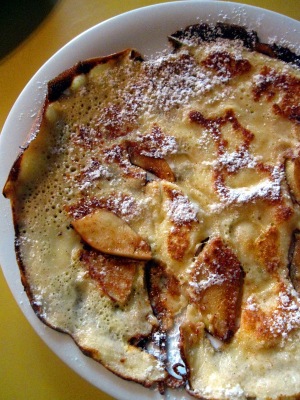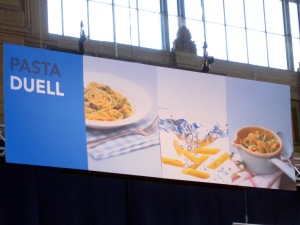Clockwise: Beef carpaccio and Swiss cheese rolls with olive oil and rösti from the Cafe de Paris (Interlaken); luxemburgerli from Confiserie Sprüngli; raclette with potatoes, pickles and pickled onions; confections to celebrate Swiss National Day (Aug 1)
“I might be done with cheese after this week in Switzerland,” I joked to the waitress. She looked at me with consternation. “Oh no, I could never be done with cheese!”
From soft to extra-hard, holey to solid, in all shades of white, amber and yellow, the Swiss love their cheese and produce about 450 different varieties of it. Whether melted in fondue pots or simply sliced in thin sheets and eaten atop bread, cheese is ubiquitous on menus and the core of most traditional Swiss dishes. Fondue is fairly common in the US so I bypassed that, but for a (relatively) less intense cheese option, you can order raclette, which is both a type of cheese and a dish featuring this cheese. The cheese round is heated, then scraped (from French racler, meaning “to scrape”) onto the diner’s plate, and usually served with boiled potatoes, pickles and pickled onions. Another popular Swiss dish is rösti, or grated, fried potatoes similar to hash browns. Be warned that if you order rösti, you will often get an entire plateful of potatoes, in the shape of the frying pan. The rösti can come topped with cheese, speck, onions or other condiments.
For those craving a sugar high, Switzerland’s other strong suit is their chocolates and sweets. If you are traveling in Zürich, be sure to grab some luxemburgerli, a confection produced exclusively by Confiserie Sprüngli. The luxemburgerli are delightfully airy, and look like miniature macarons about 1″ in diameter, with a sugar-based biscuit top and bottom, and creamy filling in the center. Traditional flavors include chocolate, vanilla, champagne and cappucino, and you can also get seasonal variations like lemon and raspberry. I tried the hazelnut and cassis (currant), and both were delicate flavor bombs, chock full of fresh, natural ingredients. Confiserie Sprüngli also produces fine chocolate products; don’t forget to try the Truffes du Jour.
Clockwise: pfannkuchen with apple and mint from Zum Guten Glück; fresh mangosteen; bratwurst with roll and spicy mustard from Vorderer Sternen Grill
To eat like the locals do, head away from the center of town and grab brunch from Zum Guten Glück, a cozy nook serving all manner of waffles, breakfast platters and pfannkuchen (somewhere between a crepe and a pancake). You can get sweet or savory pfannkuchen, topped with everything from nutella and a scoop of ice cream, to spinach and cheese, to chorizo and onions. The pfannkuchen average about CHF 12, a fantastic deal for Zürich. Another great option is the St. Galler bratwurst from Vorderer Sternen Grill, where you can grab an incredibly juicy, meaty brat, crackling hot off the grill, with a hearty roll and sinus-clearing spicy mustard for just CHF 6.50.
Cheese and sausages aside, I have to admit that my most exciting food discovery in Switzerland came inside a random ethnic grocery, where I stumbled upon fresh mangosteen. Popularly known as the “Queen of fruits,” after Queen Victoria legendarily offered £100 to anyone who could bring her the fruit, this is a tropical delicacy that is incredibly difficult to find in the US. Since the fresh fruit can harbor fruit fly pests, the Department of Agriculture bans their importation from Southeast Asia, where they are primarily grown. In recent years though, farms in Central America have been cultivating the mangosteen, which has led to the first mangosteen shipments to the US in decades, mostly to gourmet stores in LA and NYC, where the fruit sells for as much as $45/lb. Needless to say, I fell upon my first glimpse of mangosteen like a leprechaun sighting. Inside the plum-colored shell, the mangosteen segments could easily be scooped out with a spoon. Creamy, sweet, a cross between lychee and peach, with a touch of rarefied mystery. As Rudyard Kipling wrote in 1902, “You’ll know what my riddle means / When you’ve eaten mangosteens.”
Guide to other foodie stops in Zurich (many thanks to Laura for these tips):
–Globus: department store with a food floor in the basement, similar to Japanese depachika
–Terroir: Delicatessen selling Swiss products
–Heuberger: wine, chili and spice shop
–Welschland meats: carries products from French Switzerland
–Berner Bakery: grab a cherry wähe, a type of sweet tart typically eaten at lunch or dinner
–Farmer’s Market: the best ones take place on Tuesdays and Fridays at Bürkliplatz, or the Saturday market takes place at Rathausbrücke
Clockwise: the finished pasta dish, tricolor peppers, salame and soppressa all’arrabbiata; Barilla Pasta Duell tournament at the Zurich HB train station; ingredient station for the contest
Entirely unrelated to Swiss cuisine, I happened to walk into the Zurich main train station while a Barilla pasta fair was taking place inside. As I was munching on free pasta samples, a guy with a clipboard approached me and asked if I wanted to win a free trip to Rome. Before I knew it, I was signing forms in German to compete in a pasta cooking competition, standing under stage lights on a raised kitchen in front of hundreds of gawking Zurich travelers. There were four teams of two, and we needed to concoct a pasta-based creation in less than 20 minutes, then present our plates to the judges and a panel of volunteer taste testers. The announcer gave out additional directions (incomprehensible to me), shouted something, and then everyone made a mad dash for ingredients. I’ve always wondered what it would be like to compete on Top Chef and now I have a pretty good idea: when the cameraman asks you to smile and zooms in as you mince garlic, it is pretty darn distracting.
In the end, we didn’t make it into the next round (the married couple who churned out 3 different dishes came out on top), but I’d like to think we put up a respectable effort, and we received an apron and a shopping bag full of Barilla products for participating. I am now fully stocked up on pasta for the rest of the year. If you would like to try your hand at this, the Pasta Duell will be traveling to Berlin and other cities in Germany for the rest of the summer.










This looks sooo good, now I’m craving some cheese, chocolate, and some pasta! I’d like to go to other countries just to try out their different food options, it seems like it would be so much fun and by experiencing a culture fully you need to try out their food I would think.